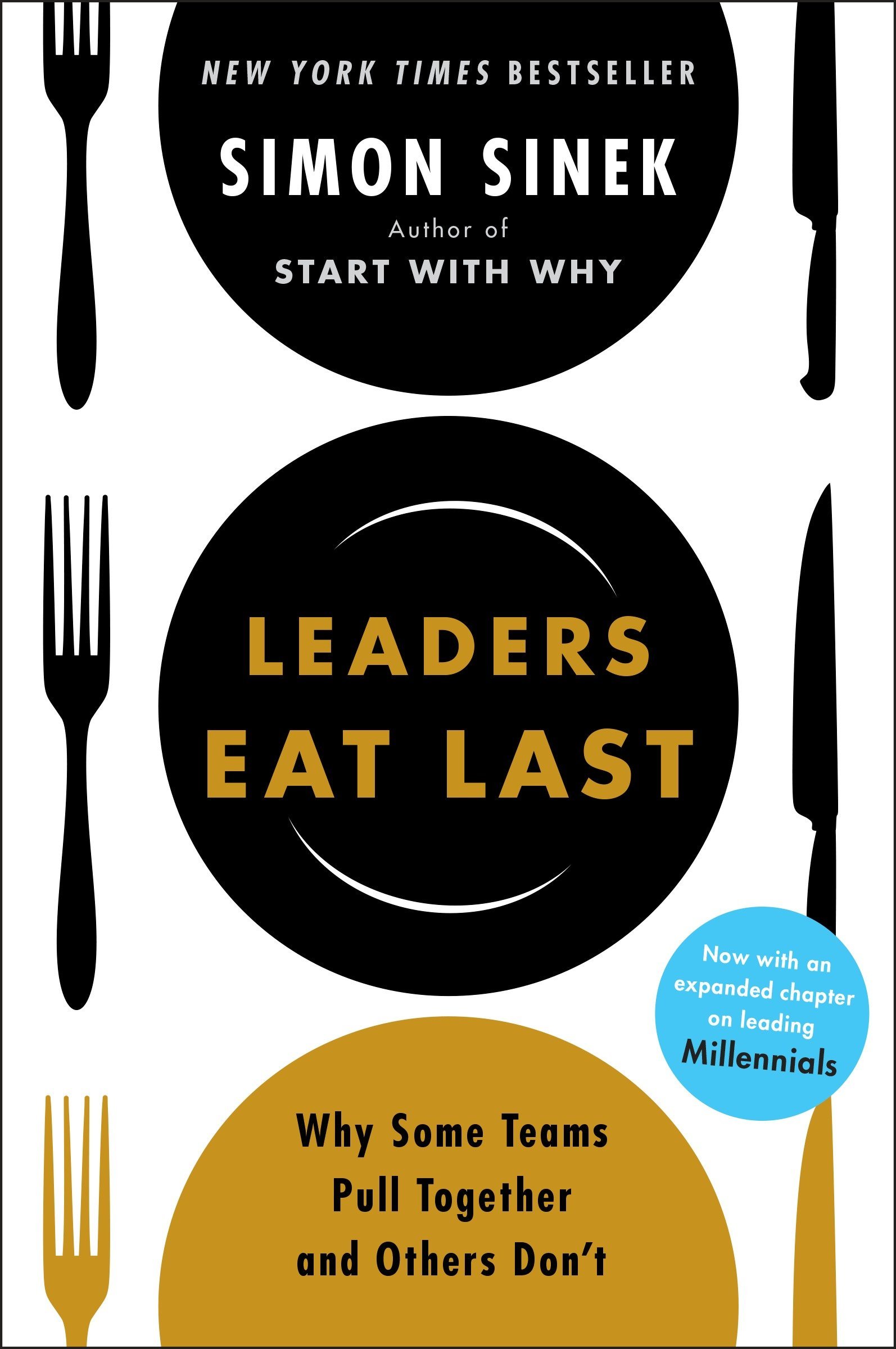INSIDER: Leaders Eat Last
Zack Snider, MBA Candidate
 When was the last time you examined the system in which you work to see the impact on the men and women within? Do our actions, policies, and expectations create places where people want to be and where they can find fulfillment?
When was the last time you examined the system in which you work to see the impact on the men and women within? Do our actions, policies, and expectations create places where people want to be and where they can find fulfillment?
Unfortunately, these are underlying questions with drastic implications for employee wellness, productivity, and performance that are missed by many managers. If we truly want our companies to be as successful as possible, it may require a radical restructuring of how we perceive the workplace and a reconciling of our goals and desires.
In Leaders Eat Last, Simon Sinek lays out the “circle of safety” that forms among members of an organization by using examples from many well-known firms that succeeded or failed in their efforts to build a “circle of safety.” In circles of safety, workers form connections with their peers and employer, belonging to something greater than themselves. Comfortable, knowing that they would support each other in times of need, workers with strong connections are better prepared to face external needs of the organization together. Forming a circle of safety is not easy, but with the following points in mind, leaders and managers will be better equipped to work with and in teams.
THINK POINT #1: Create Environments That Acknowledge Biology
Our brains are complex organs with an intricate neurotransmitter system for interpreting a wide range of bodily inputs. Our most ancient ancestors used some of these signals to drive their search for basic necessities, but the systems continue to influence us today. As scarcity diminished, work pressures, the pace of modern life, and other externalities, like social media, have impacted what our brains seek. Many find themselves in a chemical whirlwind as they go about their business, a situation that must be understood if we desire healthy teams.
Endorphins and dopamine are “selfish” chemicals, rewarding us for accomplishments that bring us back for more. Temporarily masking pain and discomfort to persevere and perform, endorphins keep us focused and enable us to persist in our efforts. Dopamine gives us feelings of satisfaction, whether from working hard towards a goal, hitting a milestone, or even meeting basic needs, like when we eat. These hits of dopamine encourage us to repeat the same activities for continued dopamine pleasure. The feeling can be addictive to a point where we inherently pursue more dopamine, even if the pursuit is harmful.
By contrast, serotonin and oxytocin are “selfless” chemicals that help us think and work for those beyond ourselves. When we receive recognition at a graduation or awards ceremony, serotonin floods our brains amidst the external recognition. We gain status and joy for ourselves, just like those recognizing us feel responsibility and pride for their part in the journey. Oxytocin is the chemical of love and the way we form deep connections and trust to bring others into our “tribe.” It lets us know our group has our backs through long-term cooperation, releasing oxytocin in our brains. It takes time to love, and it takes time to build trust.
Each of these elements has their place, and striking a balance is key. Organizations should avoid building systems that prioritize short-term dopamine releases over oxytocin, but not go so far as to remove individual drive. A lack of balance can lead to toxic environments that discourage cooperation, while placing individual gain on a pedestal. The natural desire to seek dopamine is unavoidable, so, when forming teams, incentivize and reward behaviors that boost loyalty and connection and discourage our most selfish motives.
THINK POINT #2: People, People, People
Business is a team sport, not an individual event. Like an NFL or NBA team that relies on its players, the most valuable asset for a company is its work force. The workers alone enable the business to function, so to value them is to value the company. Most organizations label themselves as people-centric, but the reality of that can vary. Perception matters, especially when people feel they are not valued. A disconnect can then emerge where employees believe the organization sees them as inhuman measures and statistics, especially when their job could be on the line.
There’s only one issue with this: oxytocin. People don’t trust and connect with numbers—people trust and connect with people. Cutting employees to help boost the bottom line and pitting employees against each other in workplace competition doesn’t build healthy teams over time. Performance goals may be met, but abstractions of their person cause worker stress levels to rise and work relationships to suffer. People lose willingness to sacrifice for each other and act in their own interests. It should be no wonder that some companies struggle with high turnover and low morale. Why should you expect loyalty and enthusiasm from an employee when they don’t feel the same from you?
Take the opportunity to invest in workers so they are fully prepared for the job at the start, develop them to improve their abilities, and nurture them to keep them productive. Most importantly, support them in failure, and encourage them to succeed later. Show that you care about your people, and they will care for you as well. Teams are made of players, so work to make your players the best they can be.
THINK POINT #3: Culture Starts at the Top
First and foremost, leaders must strike a tone and abide by it. It is not viable for a leader to tell employees to respect one another and look out for one another if they are only concerned with their own success. Self-interested attitudes will be readily apparent and any initiatives, however well designed or intended, will fall short.
Leaders must not only talk the talk, they must walk the walk. All eyes are on the leader for guidance, providing an excellent opportunity for positive impact. Be aware that how you handle adversity will be mimicked, and render each decision with the team and organization’s interest in mind, not your own. There are times when tough choices must be made for the good of the company or circumstances that require a change in staffing. Being transparent, honest, and empathetic can go a long way to making these times better. Mistakes will happen and judgments will be wrong, but what matters most is consistency in the person you claim to be and bringing that into every aspect of work.
 Ask yourself this last question to reflect on leadership and culture: If you left the organization, would it be able to function without you? Such organizations are artificial and predicated on an individual leader directing others to accomplish their vision. Protecting status and position prevents leaders from sharing their understandings and building continuity into the organization. Guidance disappears without them and internal divisions lead to infighting that can tear the organization apart. The circle of safety is missing from these setups, and a plan for the future is not possible with leaders unwilling to make sacrifices and ensure organizational stability.
Ask yourself this last question to reflect on leadership and culture: If you left the organization, would it be able to function without you? Such organizations are artificial and predicated on an individual leader directing others to accomplish their vision. Protecting status and position prevents leaders from sharing their understandings and building continuity into the organization. Guidance disappears without them and internal divisions lead to infighting that can tear the organization apart. The circle of safety is missing from these setups, and a plan for the future is not possible with leaders unwilling to make sacrifices and ensure organizational stability.
Conclusion
As Sinek explains in Leaders Eat Last, it takes every single level of the organization to build a circle of safety. Institutional inertia may push back, but the payoff is worth the effort. After all, what firm wouldn’t want a unifying force that tackles external problems while fostering a common bond to find and solve internal issues? An acknowledgement of individual reality, an emphasis on the humanity of team members, and a strong beacon of leadership are the pillars on which successful teams are built. Pursuing a circle of safety for yourself may be a lofty and challenging goal, but you will be pleased with how high your teams can fly once it forms.
. . . . . . . . . . . . . . . . . . .
Recommended Reading
Sinek, Simon (2017), Leaders Eat Last: Why Some Teams Pull Together and Others Don’t, Portfolio/Penguin: New York, NY.
. . . . . . . . . . . . . . . . . . .
About the Author
Zack Snider, MBA Candidate
Baylor University
Zack Snider is a graduate student from Harker Heights, Texas. He earned his Bachelor of Business Administration in Supply Chain Management and Management Information Systems from Baylor University. He has past work experience in logistics operations for McLane Co. Zack is pursuing an MBA and is seeking a career in procurement with a focus on healthcare supply networks.